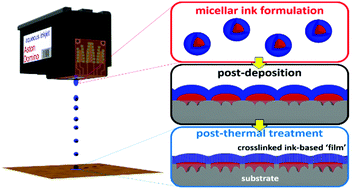Thermally triggerable, anchoring block copolymers for use in aqueous inkjet printing†
Abstract
Towards the goal of shifting from toxic organic solvents to aqueous-based formulations in commercial inkjet printing, a series of well-defined poly[(2-hydroxyethyl acrylate-stat-N-hydroxymethyl acrylamide)-block-propyl methacrylate], P[(HEA-st-HMAA)-b-PMA], amphiphilic block copolymers with varying degrees of polymerization and comonomer compositions were synthesized via reversible addition–fragmentation chain transfer (RAFT) polymerization. Optimized RAFT polymerization conditions were found to allow larger batch synthesis (>20 g scale) without compromise over molecular design control (molecular mass, hydrophobic/hydrophilic balance, dispersity, etc.). The copolymers were subsequently investigated for their crosslinking and adhesive properties, as well as jetting performance, to determine their suitability for use in aqueous ink formulations. Crosslinking was found to occur much faster for copolymers containing more of the crosslinkable HMAA monomer units and at higher molecular masses, allowing control over the required post-deposition processing time. The amphiphilic block copolymers synthesized herein demonstrate enhanced adhesive properties compared to a selection of commercial inks whilst also achieving high print quality and performance for use in aqueous continuous inkjet (CIJ) printing, which is a key step towards greener processes in the packaging industries, where printing onto hydrophobic substrates is needed.



 Please wait while we load your content...
Please wait while we load your content...